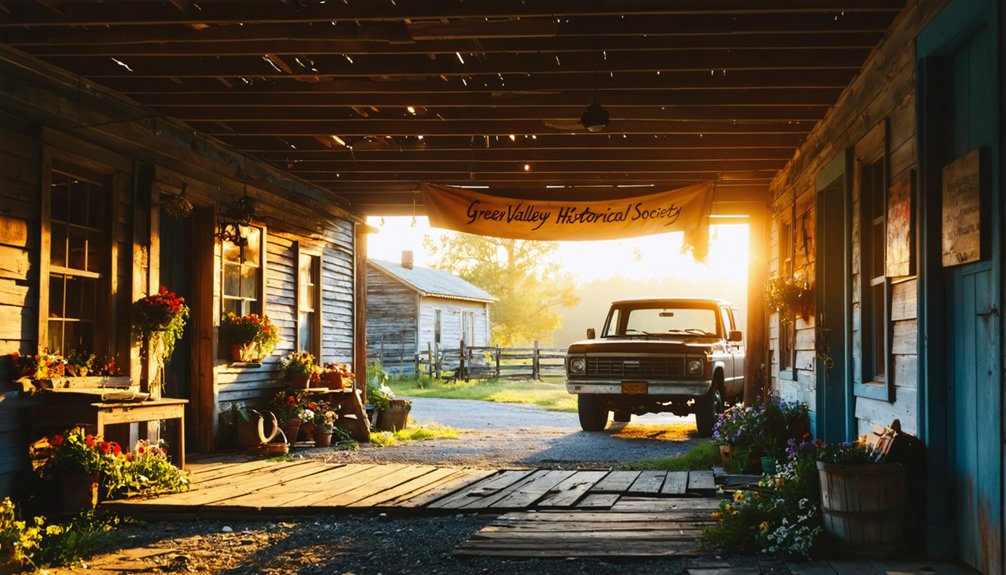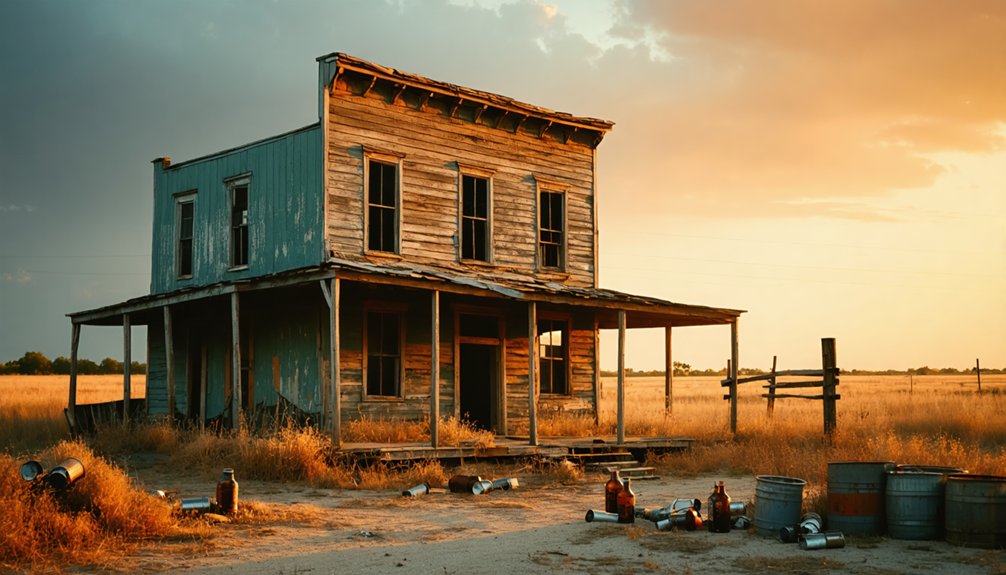You’ll find Green Valley, Texas nestled between the Elm Fork of Trinity River and Clear Creek, where it flourished as a key agricultural hub in the mid-1800s. The town’s historic schoolhouse, built in 1884, stands as a symbol of its vibrant past at the crossroads of major mail routes. While the once-bustling community has faded into a ghost town, its preserved structures and rich history offer fascinating glimpses into 19th-century frontier life.
Key Takeaways
- Green Valley was established as a Texas settlement at a major mail route intersection near the Trinity River in the 1800s.
- The town thrived as an agricultural community with a post office established in 1874 under Henry Clay Wilmoth’s leadership.
- Railroad development transformed Green Valley into a trade hub, providing employment through freight stations and maintenance facilities.
- Historic buildings, including the 1919 four-room schoolhouse and churches, remain as preserved remnants of the original settlement.
- Preservation efforts face challenges with complicated property ownership, limited utilities access, and strict zoning regulations.
The Birth of Toll Town and Its Green Valley Evolution
While the exact origin of Toll Town‘s name remains uncertain, this early Texas settlement emerged at a critical intersection of two major mail routes – one running from Sherman to Fort Worth, and another connecting McKinney to Fort Jacksboro via Decatur.
You’ll find Toll Town nestled between the Elm Fork of the Trinity River and Clear Creek, where rich soil, abundant lumber, and lush vegetation drew settlers in the mid-1800s. The area attracted pioneers and farmers who began arriving around 1870 for homesteading.
The growing community established a post office in 1874 under the leadership of Henry Clay Wilmoth, who would later suggest renaming the settlement to Green Valley.
Life in 19th Century Green Valley
If you’d lived in Green Valley during the late 1800s, you’d have spent your days tending to crops in the fertile valley soil between the Trinity River and Culp Creek, where the abundant water sources supported thriving farms.
Your children would have attended the single-room schoolhouse, built in 1884, where they’d learn amid the sounds of rabbits scurrying in the poorly sealed walls until the building’s destruction by fire in 1894.
The town’s social life centered around the school events, church gatherings, and visits to one of three stores or the local blacksmith shop, where residents could catch up on community news and conduct their business. To avoid confusion with other locations, the town became known as Green Valley, Texas to distinguish it from similarly named settlements. Like many Texas settlements of the era, residents traded with local American Indians who had established extensive trade routes through the region long before European arrival.
Daily Agricultural Activities
As the Texas sun rose over Green Valley’s rolling plains, farmers and ranchers commenced on their daily agricultural routines that would shape the town’s 19th-century identity.
You’d find farmers guiding teams of oxen through fields, turning soil for seasonal harvesting of wheat, cotton, and sorghum. Crop rotation helped maintain soil fertility while providing diverse yields throughout the year. The first commercial wheat appeared in nearby Sherman in 1833, sparking agricultural growth across the region.
In the pastures, cowboys conducted periodic roundups, branding cattle and preparing herds for drives to Kansas railheads. Small farms focused on establishing corn, beans, and squash, following agricultural practices similar to those of the early Caddo Indians.
Tenant farmers, who’d replaced slave labor after the Civil War, worked from dawn to dusk sharing crop proceeds with landowners. They’d operate reaper-binders during grain harvests, mechanizing what was once purely manual labor.
Field demonstrations introduced new farming techniques, though many farmers remained tied to traditional methods passed down through generations.
Education and Social Events
Despite the town’s modest population of fifty early residents, education played a pivotal role in Green Valley’s development through the 19th century. You’d find children learning in a subscription school, where families paid for their education in a vacant house with makeshift seating from barbed wire spools. Educational photographs documented these humble beginnings, preserving a visual record of the town’s academic growth.
By 1919, you could see significant improvements with a four-room schoolhouse featuring pot-bellied stoves and artesian well water. A major upgrade came in 1922 when a two-story brick building replaced the older structure.
The schoolhouse wasn’t just for learning – it served as the heart of community life. You’d experience educational gatherings and community celebrations that brought everyone together.
Churches of various denominations complemented these social occasions, while the local stores and post office created additional gathering spots.
Whether you attended a graduation ceremony or a school event, you’d feel the strong sense of civic pride that united Green Valley’s residents.
Railway’s Impact on Town Prosperity
While countless frontier settlements dotted the Texas landscape in the late 1800s, Green Valley’s destiny was fundamentally shaped by the railroad’s arrival.
You’ll find that the railroad influence transformed this once-modest settlement into a bustling trade hub, with freight stations and maintenance facilities providing steady employment for local residents. Similar to the arrival of the Texas & Pacific Railway in 1881 that established Abilene, Green Valley experienced rapid development with the coming of the rails. The town’s merchants thrived as they served both railroad workers and travelers passing through on the line.
These economic shifts brought unprecedented prosperity as Green Valley’s ranchers and farmers gained direct access to broader markets. Much like the Kansas City, Mexico and Orient Railway that gave rise to towns like Girvin in 1912, the railroad’s presence determined which settlements would flourish.
The railroad depot became the heart of the community, spurring the development of hotels, general stores, and other businesses along the tracks.
Like many Texas towns of that era, Green Valley’s very survival hinged on maintaining its essential rail connections.
Preserved Landmarks and Historical Sites
Several significant landmarks stand preserved at Green Valley’s historic site, offering glimpses into this former frontier settlement’s rich past.
You’ll find the original school building, now repurposed as a community center, showcasing late 19th-century rural Texas architecture. The historic church remains active, maintaining its cemetery grounds where early settlers and Polish immigrant miners rest.
A brick wall from 1913 demonstrates the skilled masonry of the mining community, while landmark preservation efforts have protected key structures that keep cultural memory alive.
The land’s modern use blends history with accessibility – the northern section hosts an RV park, while the U.S. Army Corps of Engineers safeguards much of the surrounding area in connection with the Ray Roberts Lake project.
Modern Day Remnants and Community Spirit

You’ll find that several historic buildings in Green Valley remain standing and actively used today, including the repurposed school building that now serves as a community center and the still-functioning church.
The local cemetery continues to be maintained, demonstrating the community’s commitment to preserving its heritage and connections to the past.
Through these preserved landmarks and ongoing community activities, Green Valley maintains a unique balance between its ghost town status and its identity as a living, breathing community.
Historic Buildings Still Standing
The historic landmarks of Green Valley stand as resilient monuments to the town’s vibrant past, with three key structures forming the heart of this Texas ghost town’s architectural heritage.
You’ll find the schoolhouse, now serving as a bustling community center, showcasing the architectural significance of late 19th-century rural Texas design. The church continues its original purpose, while the cemetery chronicles the area’s founding families through preserved headstones.
Four key elements of historic preservation in Green Valley:
- Original period materials and craftsmanship remain intact
- Active community use guarantees ongoing maintenance
- Buildings retain authentic structural elements
- Strategic adaptations support long-term survival
These enduring structures don’t just represent bygone days – they’re living connections to Green Valley’s heritage, still serving the community’s needs while preserving its rich history.
Local Preservation Efforts Continue
Despite significant challenges facing historic preservation, dedicated local groups in Green Valley have rallied to protect and celebrate their town’s heritage through innovative educational programs and strategic partnerships.
You’ll find community initiatives like guided tours led by passionate volunteers who connect students with their local history, while state preservation funding has helped tackle critical restoration needs.
The preservation challenges are substantial – from complicated property ownership issues to limited utilities and strict zoning regulations.
Yet, you’ll discover how residents have adapted through minimalist living strategies and resource sharing to maintain their presence. They’re working closely with historical commissions and benefiting from property tax relief programs.
Through cultural events and school partnerships, Green Valley’s spirit endures as locals fight to preserve their town’s legacy for future generations.
Legacy Among Texas Ghost Towns
Among Texas ghost towns, Green Valley stands apart due to its enduring community presence despite its technical ghost town status. Unlike many abandoned towns that completely disappeared after railway bypasses, Green Valley maintains its cultural significance through active preservation of key structures and community identity.
Green Valley defies the typical ghost town fate, keeping its spirit alive through preserved landmarks and an active community presence.
The town’s unique legacy is evident in these distinguishing features:
- Active use of historic structures including the church, schoolhouse, and cemetery
- Successful preservation efforts led by the Green Valley School Historical Society
- Official recognition through a Texas Historical Commission marker in 2001
- Ongoing community gatherings in the restored schoolhouse
You’ll find Green Valley’s spirit alive in the RV park that brings new visitors and the U.S. Army Corps of Engineers’ careful land management for Ray Roberts Lake, showing how this ghost town continues to adapt and serve its community.
Frequently Asked Questions
What Indigenous Tribes Originally Inhabited the Green Valley Area?
Across 250,000 square miles of territory, you’ll find the Comanches dominated Green Valley’s native tribes, while Apaches, Kiowas, and Tonkawa peoples contributed to the region’s rich cultural heritage.
How Many Students Attended Green Valley School at Its Peak?
While exact student demographics aren’t documented, you’ll find the peak enrollment was likely 40-50 students based on the school’s four-room capacity and typical rural school achievements of that early 1900s era.
What Were the Main Agricultural Products Grown in Green Valley?
You’ll find that corn, wheat, and oats were the primary crops, with local vegetable gardens supporting families. While cotton production and wheat farming likely occurred, specific records don’t confirm their scale.
Were There Any Notable Crimes or Lawlessness in Green Valley?
You won’t find records of significant crime incidents or lawlessness in the community’s history. Unlike other ghost towns, there’s no evidence of major law enforcement challenges or criminal activity.
What Was the Average Property Value in Green Valley During 1880S?
You’d find property values were likely $1-5 per acre, reflecting economic factors like limited population, lack of railroads, and agricultural focus, though no precise records exist from Green Valley’s 1880s period.
References
- https://en.wikipedia.org/wiki/Green_Valley
- https://www.geotab.com/ghost-towns/
- https://en.wikipedia.org/wiki/List_of_ghost_towns_in_Texas
- https://dentoncountyhistoryandculture.wordpress.com/2019/04/18/history-of-the-green-valley-community-and-school/
- https://texashillcountry.com/abnormally-named-ghost-towns-texas-hill-country/
- https://www.tshaonline.org/handbook/entries/green-valley-tx-guadalupe-county
- https://www.tshaonline.org/handbook/entries/green-valley-tx-denton-county
- https://www.texasescapes.com/Texas-Ghost-Towns-A-to-Z.htm
- https://www.hmdb.org/m.asp?m=191463
- https://www.dentonhistory.net/page52/page87/greenvalley.html



